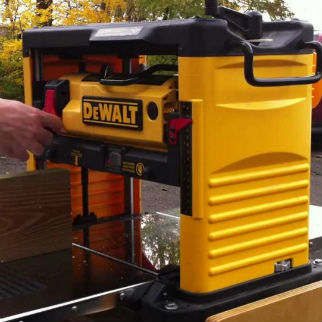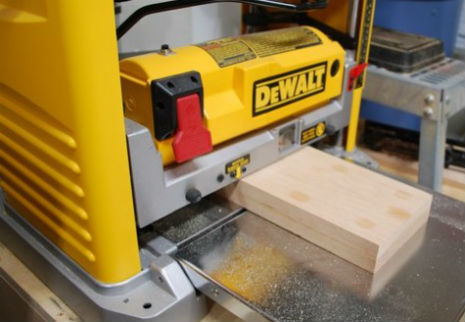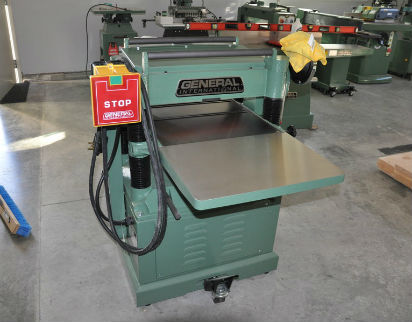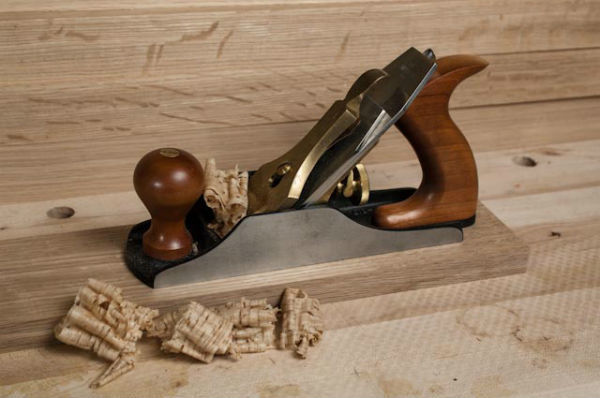A planer is one of those tools that you don't really hear about that often but they do serve a specific purpose. I bet most people wonder what a planer is and what they really mean is... what can they do?
Right?
They can come in handy for certain things but knowing what they are and how they work will determine whether you will ever consider getting one for yourself...

If you do a lot of woodworking or work with a lot of reclaimed woods, then a thickness planer will be right up your alley. If you are a carpenter, then you will probably be more interested in an electric handheld planer. If you are a woodworker, then the manual hand planer is going to be your best bet.
Let's take a closer look at planers to see if they might be something you will end up adding to your tool arsenal...
What Is A Wood Planer?
A planer is designed to take off small amounts of material from a wooden surface which is oftentimes used to get boards to the same thickness. There are two main types of planers, a thickness planer and a hand planer (manual and electric) and they both work using the same principals but are better suited for specific tasks.
A thickness planer works better for maintaining a specific thickness (as the name implies) of a board and can usually accommodate larger dimensional lumber compared to a handheld model.
A hand planer will work better in situations where the workpiece is not movable (because of weight or an awkward shape) or is too large to fit in a thickness planer. An electric hand planer will remove material faster than a manual hand planer but will not have as nice of a finished edge and would not provide as much control over the amount of material that can be removed either.
How They Work...
All planers work the same way, they have a cutting blade located in the middle of the tool (usually) that takes off a small amount of wood (usually around 1/8" max.) at a time.
The cutter works more like a sharp chisel would if you were to run it on a piece of wood but a planer uses a much wider blade (thickness model especially) to take off more material at a time and it is a much more controlled motion tool, resulting in a much smoother, more uniform appearance after it is cut.
What Kind Of Things Are They Useful For?
Even though all of the planers serve the same basic purpose, they all have a slightly different use, mainly due to their design.
Thickness Planer: A thickness planer really comes in handy when you want to create a nominal thickness in the wood you're working with. For instance, if you are taking on a project that requires all of the 2x4s to be the same thickness, then a thickness planer would be your go to tool because that's exactly what they're made for.
Likewise, you could run old decking boards (or any kind of board) through it and get that new wood finish to come back by removing a very thin layer off of the top.
Benchtop Models: A benchtop thickness planer is a smaller unit than a floor model and these usually have the capacity to take up to a 12 inch or 13 inch wide piece of lumber and can take materials of up to 3 inches thick as well, pretty impressive!

woodlogger.com
These are lighter weight and can be moved around pretty easily, the average weight being somewhere around 60 - 90 pounds. These are pretty moderately priced as well and can cost anywhere between $250, although it up to $600 for a more premium model that has a few more features to.
Floor Models: These are much larger units that way several hundred pounds, on average but these can handle lumber that is very wide (15" - 24") and can cost anywhere from $1000, all the way up to $4000 or more!
Some of these will run off of 120 V of electricity but I would have to say that most of these will need a 240 V connection and are better suited for a dedicated shop. These will have much more power than the benchtop thickness planers and will usually have much better blades (and other parts as well) which will give you a much nicer finished edge when it's all said and done.

lumberjocks.com
Electric Hand Planer: Electric hand planers do not have nearly as wide of a cutting blade as a thickness planer (usually only about 3" wide) is going to have but they do come in handy for certain circumstances. These types of planers have the advantage of being portable, so they can plane a surface that is permanently in place and is the major advantage of having one of these over a thickness planer.
Woodworking projects will usually use one of these for taking off small amounts of material quickly and other professions like carpenters will use them on the inside of the house to plane down studs that stick out farther than others, which helps keep the drywall straight.

Manual Hand Planer: A manual hand planer is usually used in woodworking projects and since there is no electrical motor that powers the tool, you have to use good old-fashioned elbow grease to remove material. The advantage to one of these is the fact that you can really control the amount of material you take off and you are way less likely to gouge the workpiece in the process.
These come in many different sizes (lengths and widths) and are a very common tool for woodworker to have and maybe even some carpenters if you're working on a more historical building and trying to match existing pieces.
Just for the record, there are many different hand planers out there so categorizing them just in one single type of tool would be incorrect. Some of the different manual hand planers are going to have special features integrated into them that will work better for specific task.
Some examples of just a few different kinds of hand planers (or planes) that are out there are:
Smoothing Plane: This is a finish plane and is used for making the final etches in the workpiece. It can be just as effective as sandpaper (if in the right hands) and makes a very fine finished edge.
Jack Plane: Is used for smoothing out twisted and warped pieces of lumber and is usually the first plane used in this process. It is labeled as more of a "general purpose" plane and will work well for a variety of tasks.
Scrub Plane: This is one of the roughest finishes that a plane can have (but is still pretty clean) and a scrub plane is used for taking out much more material in a single pass. These are used first usually (next to a jack plane) and will shape material quickly.
There are a few more types out there, but I wanted to give you a basic overview of what's out there and to make the article a more complete resource as well!
I will probably do a more in-depth article later on on the different planes, how to use them and where to find them later on and will update this article when I do.

highlandwoodworking.com
Where Can I Find One?
Just about every one of these planers can be found online and some box stores like Home Depot and Lowe's have thickness planers and even some hand planers in stock.
From what I gathered, if you shop online you are going to have a much better variety from different manufacturers and many different types of planers to choose from. If you were to take a quick look at Amazon, you would see many different planers and probably one of the biggest selections online, which is no surprise.
If you prefer to buy "in-store" then places like Home Depot and Lowes would be a pretty good choice although I found that Home Depot has a little bit better selection overall. Something to keep in mind is that box stores like this will only have 2 to 3 different models (in most cases) to choose from and these will probably be the most popular selling models.
If you want variety, I would recommend going online, somewhere like Amazon first but you could also check out Home Depot's online selection which is a whole lot better than their in-store selection and you would have to have the planer shipped to you but no different than ordering online anyways, so your choice.

